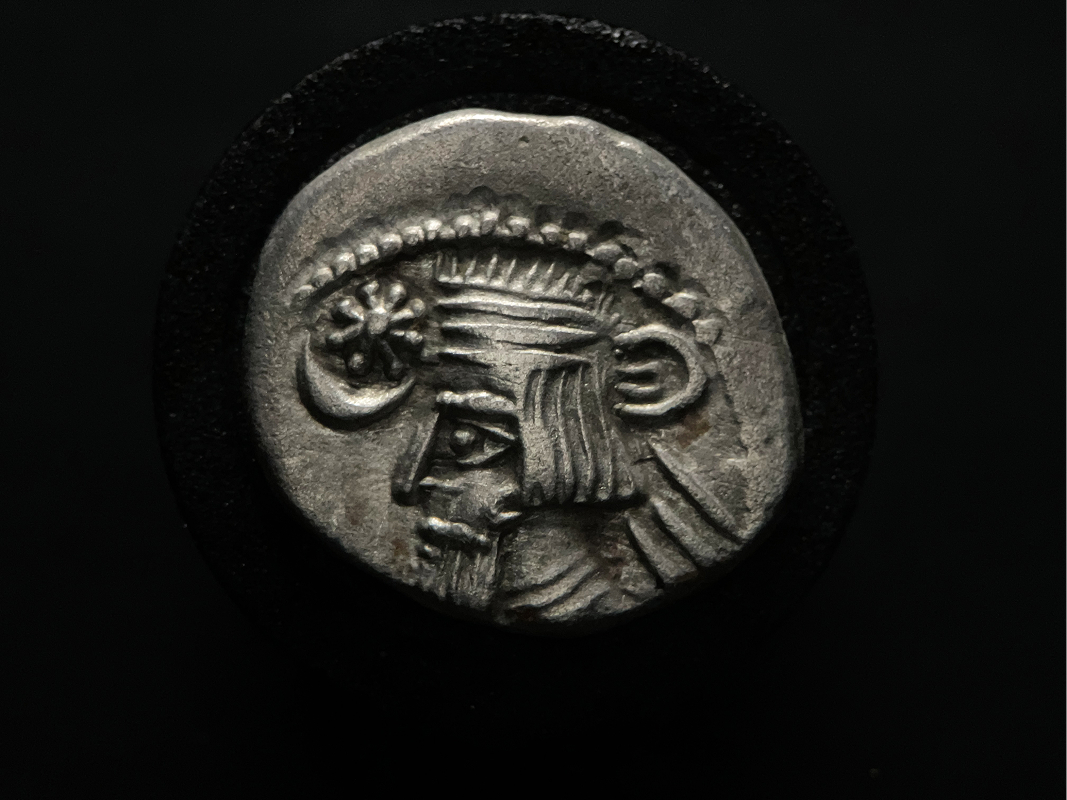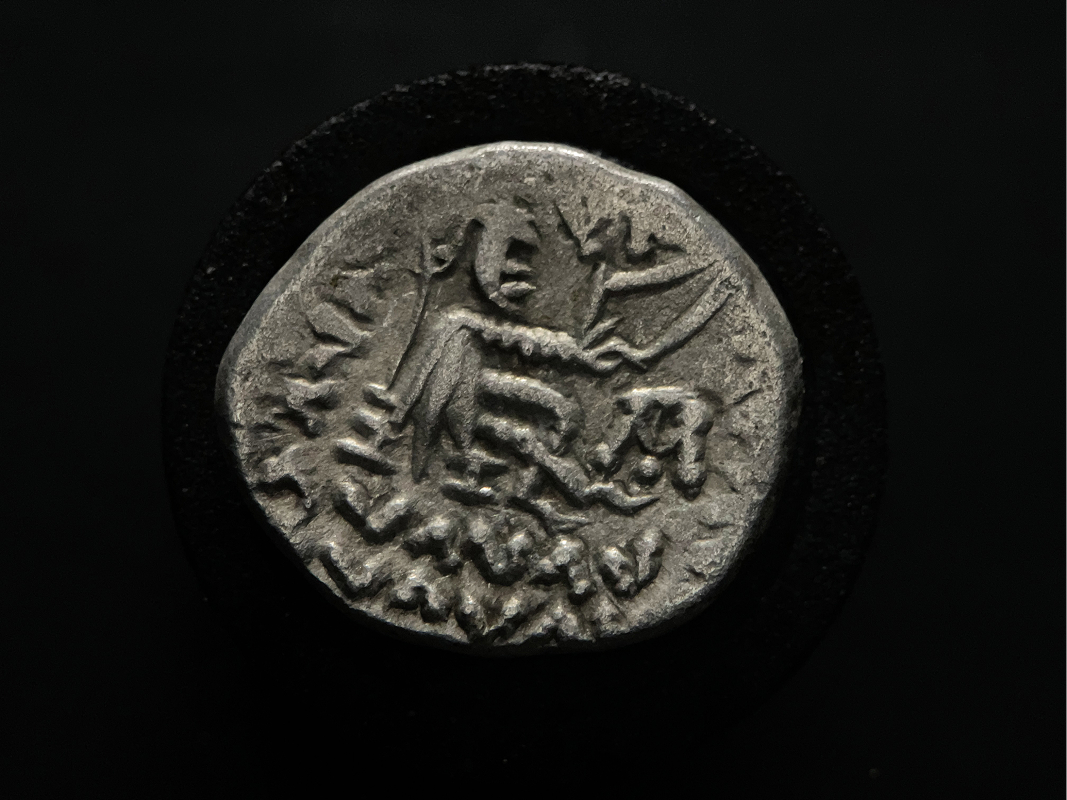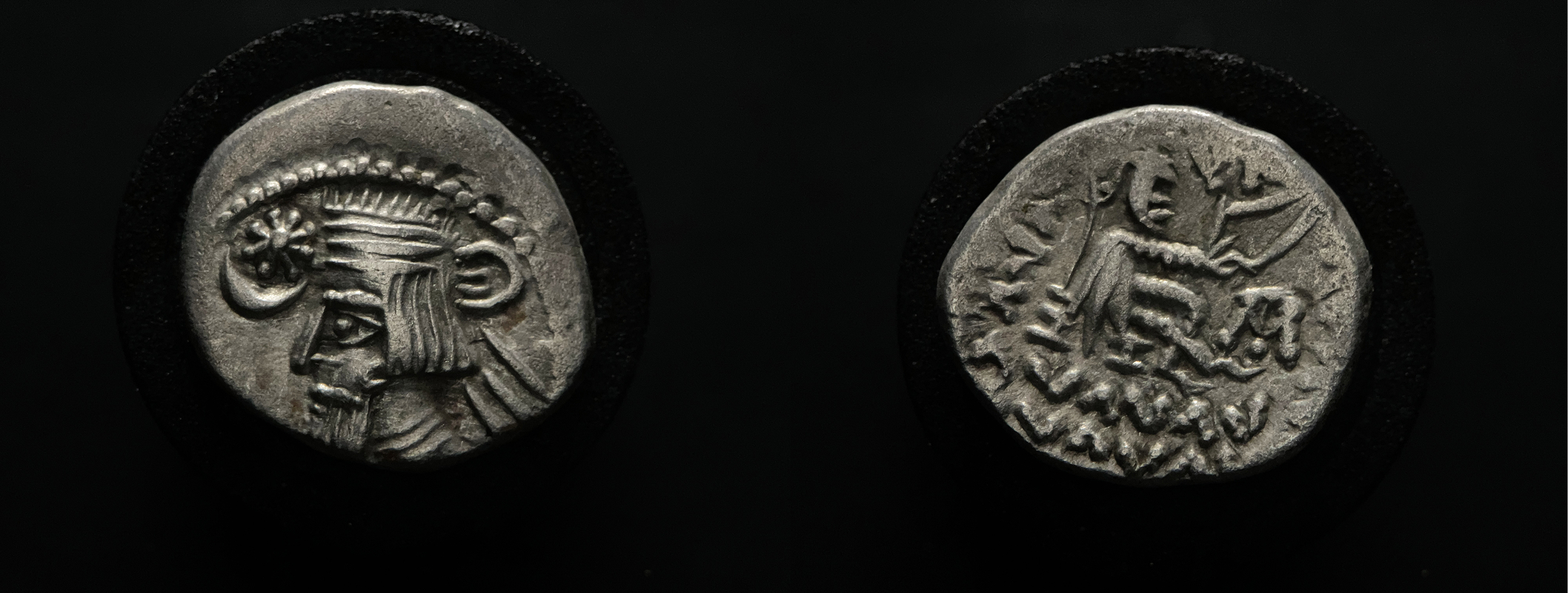Introduction
This silver drachm comes from the reign of Artabanos IV, one of the later rulers of the Arsacid dynasty of the Parthian Empire, which dominated the Iranian plateau and Mesopotamia from the 3rd century BC to the early 3rd century AD. Artabanos IV ruled between AD 10–38, a period marked by dynastic civil wars, Roman interference, and widespread regional instability.
Yet despite these challenges, the Parthian royal house maintained a strong imperial identity, and coinage played a crucial role in projecting legitimacy, dynastic continuity, and religious symbolism. This drachm, minted likely at Seleucia-on-the-Tigris or another prominent mint city such as Ecbatana, reflects a world where Iranian monarchic traditions merged with Hellenistic aesthetics and Zoroastrian ideology.
The Parthian Empire served as a buffer zone between the Roman West and the Kushan and Han empires in the East. It was a multi-ethnic empire composed of Persians, Medes, Babylonians, Armenians, and Greeks, reflected in the use of Greek inscriptions on coins well into the first centuries AD.
About the King: Artabanos IV
Artabanos IV (often also referred to as Artabanus II in older scholarship) came to the throne during a turbulent time. The Arsacid throne was deeply contested after the death of Phraates V, and Artabanos was backed by eastern factions, particularly from Media and Elymais. His primary rival early on was Vonones I, a Roman-educated Parthian who ruled briefly with Roman support but lacked native backing.
Eventually, Artabanos IV expelled Vonones and consolidated power over the empire, though his rule remained contested. He clashed frequently with Roman interests, including attempts by the Romans to influence the succession of Armenian kings. His reign saw several campaigns in Armenia, Cappadocia, and Mesopotamia, with sporadic peace negotiations and breakdowns.
Despite the internal divisions and external threats, Artabanos IV successfully held the empire together and continued the Arsacid legacy of divine kingship through coinage and ceremony.
Obverse Description
- Portrait: Bearded and diademed bust of King Artabanos IV facing left.
- Headdress: He wears a domed tiara with a distinctive crenellated edge, typical of late Parthian rulers.
- Symbols:
- Crescent moon in front of the face.
- Eight-petaled rosette or star, symbolizing Ahura Mazda or divine favor.
- Elaborate hair and beard lines, stylized, almost abstract.
This style combines Iranian royal iconography with the Greek-Hellenistic artistic influence inherited from the Seleucid era, illustrating a blend of eastern ideology and western form.


Reverse Description
- Central Motif: A seated archer (symbolic representation of Arsaces I, the dynasty’s founder).
- Inscription: Greek legend around the archer:
- ΒΑΣΙΛΕΩΣ ΒΑΣΙΛΕΩΝ ΑΡΣΑΚΟΥ
“Of the King of Kings Arsaces”
- ΒΑΣΙΛΕΩΣ ΒΑΣΙΛΕΩΝ ΑΡΣΑΚΟΥ
Though this coin was minted under Artabanos IV, the title “Arsaces” was retained by all kings of the dynasty, a tradition meant to honor the founding monarch and promote continuity.
The seated archer became the standard reverse type on Parthian coinage for nearly 300 years, emblematic of the warrior nobility (azatan class) and the archery-based military prowess that defined the Parthian elite cavalry.
Cultural, Political, and Numismatic Significance
- Political Messaging: The coin projects legitimacy, divine sanction, and continuity during a reign marked by civil war and external threats.
- Zoroastrian Influence: Celestial symbols (moon, star/rosette) emphasize the connection between the monarchy and the divine order (asha), central to Zoroastrian cosmology.
- Greek Language Use: Despite being an Iranian empire, Greek remained the language of administration and coinage, preserving the Hellenistic traditions long after the fall of the Seleucid Empire.
- Legacy: Artabanos IV’s coinage stands as a resilient continuation of Arsacid power, which would eventually give way to the Sasanian dynasty in AD 224.
Numismatic & Technical Details
Reign: AD 10–38
Mint: Possibly Seleucia-on-the-Tigris or Ecbatana
Metal: Silver
Weight: 3.81g
Diameter: 17.40mm
Die axis: 12h
Reference: Sellwood 63.x (var.)
Numismatic Notes
- Condition: This example shows excellent detail in the bust and significant legibility in the reverse inscriptions.
- Strike: Well-centered with good metal quality and a near-complete strike of both devices.
- Comparative Rarity: While drachms of Artabanos IV are not rare, well-preserved examples like this, with strong obverse motifs and a clean archer reverse, are sought after by collectors focusing on Parthian, Iranian, or Silk Road numismatics.
Interested in This Coin?
If you’re drawn to the rich history of the Parthian Empire and are looking to add this authentic silver drachm of Artabanos IV to your collection, we’d love to hear from you. Whether you’re a dedicated collector, a history enthusiast, or curating an educational set, this piece is an evocative relic of Iran’s imperial legacy.
Contact us today to learn more or inquire about availability.
Catalog ID: PAR-ARTA4-AR-DR-001

